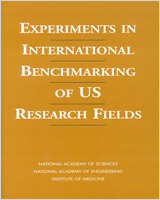Experiments in International Benchmarking of US Research Fields
Authors
National Academy of Sciences (US), National Academy of Engineering (US) and Institute of Medicine (US) Committee on Science, Engineering, and Public Policy.How can the federal government gauge the overall health of scientific research--as a whole and in its parts--and determine whether national funding adequately supports national research objectives? It is feasible to monitor US performance with field-by-field peer assessments. This might be done through the establishment of independent panels consisting of researchers who work in a field, individuals who work in closely related fields, and research "users" who follow the field closely. Some of these individuals should be outstanding foreign scientists in the field being examined. This technique of comparative international assessments is also known as international benchmarking.
Experiments in International Benchmarking of U.S. Research Fields evaluates the feasibility and utility of the benchmarking technique. In order to do this, the report internationally benchmarks three fields: mathematics, immunology, and materials science and engineering, then summarizes the results of these experiments.
Financial Support: The development of this report was supported by the Sloan Foundation and the National Research Council.
NOTICE: This volume was produced as part of a project approved by the Governing Board of the National Research Council, whose members are drawn from the councils of the National Academy of Sciences, the National Academy of Engineering, and the Institute of Medicine. It is a result of work done by the Committee on Science, Engineering, and Public Policy (COSEPUP) as augmented, which has authorized its release to the public. This report has been reviewed by a group other than the authors according to procedures approved by COSEPUP and the Report Review Committee.
The Committee on Science, Engineering, and Public Policy (COSEPUP) is a joint committee of NAS, NAE, and IOM. It includes members of the councils of all three bodies.
